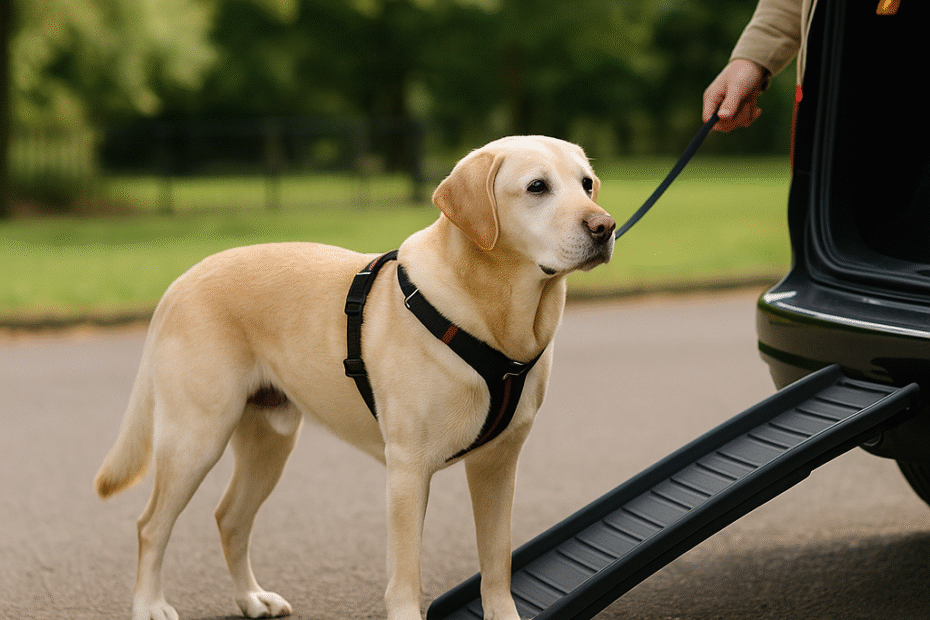As dogs grow older, their bodies begin to ask more of us. Joints stiffen, muscles tire more quickly, and movements that once felt effortless now take more thought. Mobility and comfort: when training meets ageing bodies is a topic we do not talk about nearly enough. But understanding how to adapt training as your dog ages can help maintain their independence, reduce stress, and support their wellbeing.
Small Adjustments Make a Big Difference
It might start with something simple. Your dog no longer wants to jump into the car. They hesitate before using stairs. They sit more slowly or choose not to sit at all. These are not signs of disobedience. They are your dog’s quiet way of saying something no longer feels quite right.
This is where thoughtful training comes in. Rather than asking for the same behaviours in the same ways, we can adapt our cues to suit changing needs. “Sit” can become “stand” or “wait”. Instead of climbing into the car, your dog might learn to pause calmly while you assist them with a ramp.
Mobility and comfort: when training meets ageing bodies is about listening to your dog’s new limits, then finding kind and practical ways to support them.
Encouraging Movement Without Pushing Through Pain
Movement is still important for older dogs. It keeps joints lubricated and muscles active. But it needs to be the right kind of movement. Gentle leash walks, balance games, and slow sniffing in the garden offer both physical and mental stimulation without placing strain on the body.
In some cases, you might teach your dog to move in a more deliberate way. For example, using a cue like “slow” when walking downhill, or “step up” when approaching a kerb. These give your dog time to prepare their body and reduce the risk of discomfort.
The key is not to stop moving. It is to move with intention.
If you think your dog might be in pain then it’s so important that you see your vet for a health check. There are medications and therapies that can help minimise pain for your dog, or even help them be pain free.
Brock, now considered an old man in Great Dane years is on medication prescribed by his vet team, takes a supplement specifically for spinal support, and sees Neil at Animal Holistic Therapies every month.
Comfortable Training for Everyday Routines
Even basic routines like grooming and vet visits can become challenging as dogs age. Holding a paw may feel uncomfortable. Rolling over might no longer be easy. Through cooperative care training, we can offer alternatives.
Your dog can learn to rest their chin on a towel while you trim around their eyes. They can learn to place a paw on a stool rather than lifting it into the air. These are gentle changes, but they show your dog that they are being listened to and not forced.
Mobility and comfort: when training meets ageing bodies also means teaching ourselves to observe more closely and ask more often: “Is this still working for my dog?”
The Role of the Environment
The home environment plays a major part in your dog’s comfort. Rugs can help with traction. Raised food bowls can reduce neck strain. Orthopaedic beds provide better rest. But even the best tools mean little without understanding how to help your dog use them.
That is where training blends into daily life. Guiding your dog to their mat. Helping them learn where the water bowl has moved. Reinforcing calm behaviour when resting, so they are not startled by activity around them.
With a bit of planning, comfort and learning can live side by side.
Supporting You Both
It can be hard to watch our dogs slow down. But slowing down is not the same as stopping. With a few changes, training can continue to be a source of connection, and calm.
If you would like support tailored to your dog’s mobility and comfort needs, I offer in home consultations that focus on practical solutions and kind guidance.
Mobility and comfort: when training meets ageing bodies is not about lowering expectations. It is about changing them in ways that honour the dog your companion is today.
Game On!
Let’s Play!
Hxx
Written with the assistance of AI

